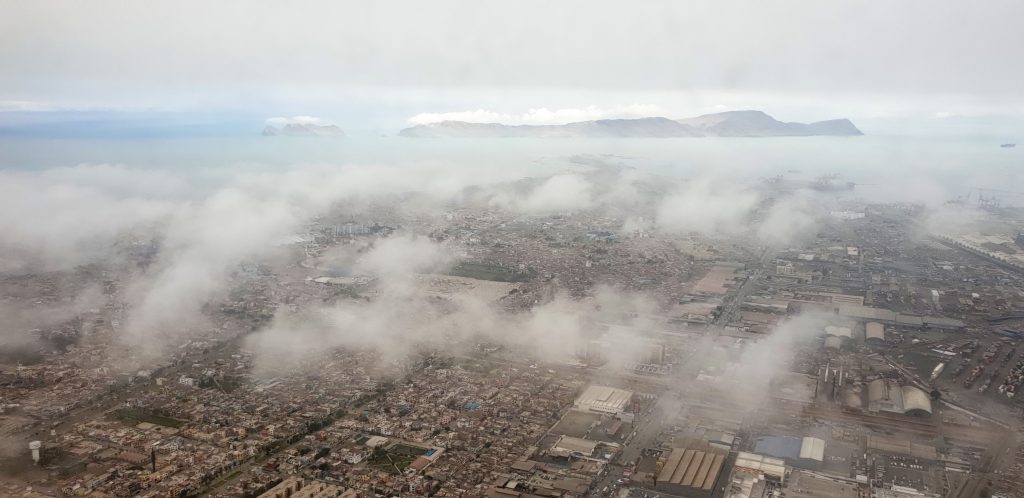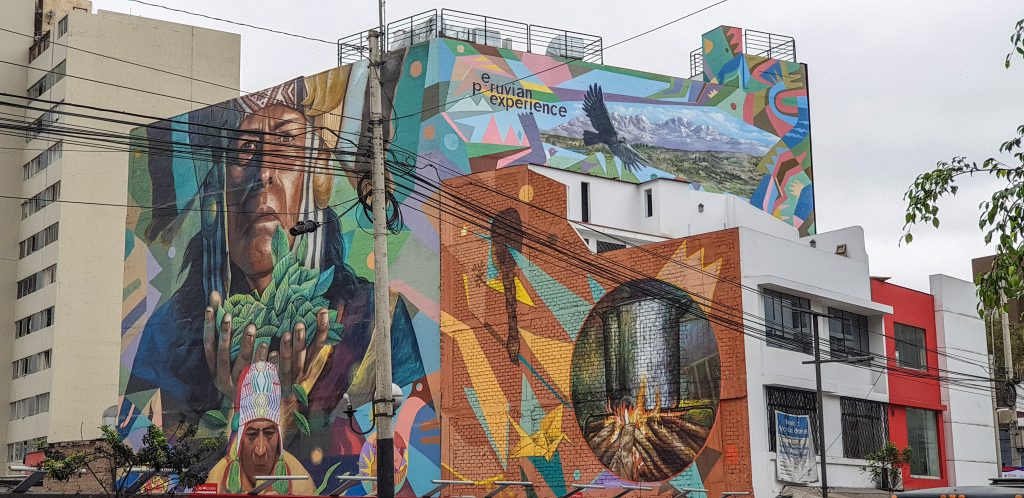This is our last blog entry for this journey and we wanted to say a few words about Lima as we are spending our last days in Peru here.
Lima is by all means not a pretty city. It does have a nice old center of town and a nice bohemian quarter called Barranco, but by and large Lima’s skyline is a wild array of small and tall buildings, old and new houses, some well maintained, many nearly falling down.

Many only look half built with their roofs missing and electric wires going in all directions. A building code seems to be absent. The weather during this time of year is overcast during, you won’t see any sun for month. The ‘Limeño’ are talking about ‘good weather’ when it’s not drizzling.

Our hotel is a charming old house with a nice little patio but it is dwarfed by much larger, ugly buildings left and right. Nevertheless the city does reveal it’s nicer sides once you start looking beyond the outer veneer.

Lima is surprisingly clean as far as we could tell. Trash cans everywhere and people cleaning up the streets and tend to the public gardens. When jogging (or scootering along as Jiho and Chris did) along the high cliff line one has a beautiful view of the ocean even though the view directly below is oring. A multi lane highway hugs the beach line below and not much else has space there.
Lima has the wonderful Museo Larco with it’s spectacular collection of ancient artefacts.

And it has roped off several large pieces of land in the middle of Lima for excavation purposes (no one knows how much of Lima is actually built on top of such ruins). One of those ruins, the Huaca Pucllana, is a huge temple pre-Inca that is made out of millions of bricks in book shelf fashion, in order to withstand the earth quakes.

The largest Pyramid glowing in yellow light at night was a mound of mud not too long ago and was only recently excavated and made available to the public. There at the Huaca Pucllana Restaurant, overlooking the illuminated ruins one evening, we had one of the best dinners of the trip.


This leads us to the best side of Lima as far as we could tell. The incredible variety and freshness of food and amount of restaurants in Lima. No matter where we went, we did not have a bad meal. This is actually true of all of Peru, but in Lima you could go out every night and not eat at the same restaurant for years. Many are very small. Just 5-6 tables but the taste and freshness is always there.
Let’s hone in on some of the most traditional meat dishes:
Lomo Saltado, a beef stew with vegetables. Always delicious. And so often where we went there is an enticing smell of grilled meat in the air that makes your mouth water.
Then there is of course Cui (for the sound they make…) aka conejillo de indias, the guinea pig. Served as a stew or in whole (which made even Chris regret his choice once…) complete with little paws and little head. It probably has an amount of meat on it like a whole chicken. It is a fairly lean meat, nevertheless sometimes surrounded by pockets of fat (depending on the guinea pigs constitution).
Chris also tried alpaca, which tastes a bit like veal, but with very little flavor. Apart from that chicken and pork are also eaten.

Then of course there is the seafood. For seafood lovers Lima is heaven. Chevice was invented here and you can get it in all variations in pretty much every restaurant. Any kind of fresh sea food is on the menu: Octopus, clams, shrimp, fish of all kinds, etc.

Vegetables are basically many of the same we have, but fried yucca and plantains (cooking bananas) are two which we really enjoyed that are harder to find in the US and Europe.
Peru is also a country for fruit lovers. There is so much fresh tropical fruit here, you can eat it every day nearly right from the tree. Pineapple, papaya, coconut, banana, melons, oranges and other citrus fruit are known to all of us, but they taste much fresher here. Some of the more exotic varieties are the Mamey fruit and Grenadille (a sweet passion fruit). Fresh juices can be found everywhere, frozen or not. What a treat!
And there is always fresh and delicious avocado to be had. Much different than the green picked ones we get.
The main meal of the day in the country side is actually lunch, not dinner. For dinner often just a hearty soup is served. In many salads and soups Peruvians use quinoa (rice of the Inca), which became quite the fashion as one of the superfoods in western countries recently.
Peru also offers a variety of very nice snacks like empanadas or churros to go. Also very popular is the salted corn ‘ Chicha’ (like unpopped popcorn, salted and consisting of huge corn kernels, much larger there than at home. Those are very crunchy and can be very hard to crack some times)
Last but not least we can’t forget the deserts! Peruvians love desert and wherever you go you will find a blend of all sorts of deserts. From lime and fruit pies to mousses and crèmes, each restaurant has at least a few options to choose from. Needless to say, our desert foodies Chris and Sally were in heaven!
Drink wise everything can be bought in Lima. Three traditional drinks are ‘Chicha morada’ the fermented sugar cane juice, quite pleasant to drink when cold, Pisco Sour a highly alcoholic drink resembling a Margarita.

We also liked Chocolate tea. Yes, you have heard right. This is tea made of cocoa leaves and crunched cocoa shells that does indeed taste like hot chocolate, but in tea form. This is hard to describe, but true! Actually you can buy it at the german supermarket REWE (Feine Welt collection) as we saw upon our return.
It was a wonderful trip to Peru, a great and hilariously funny Hatun Runa team and despite some of the hard hiking and riding we did, we got compensated many times over by the friendliness of the people here, the magnificent unspoilt nature and the fabulous food of Peru.
Mucho me gusta! 🙂

















